Need Help? We are right here!
Search Results:
×SAML or Security Assertion Markup Language is a crucial XML-based protocol in the realm of Identity and Access Management (IAM). It facilitates the secure exchange of authentication and authorization data between the service provider or SP (which can be the application or resource that users need to access) and the identity provider or IDP (which verifies the identity and authority level of the user). The ultimate goal of SAML is to enable this process called Single Sign-On (SSO) which empowers users to access multiple applications with a single set of credentials.
SAML 2.0 is the improved version of the original SAML, which has increased flexibility, enhanced security, and support for federation and all these things have made it the de facto standard for implementing Single Sign-On (SSO) and secure identity solutions like Multi-Factor Authentication (MFA). When it comes to SAML SSO or MFA, the SAML 2.0 protocol is popularly used. Most legacy applications are used in on-premise environments, and even modern application hosted on the cloud supports SAML authentication.
The Single Sign-On process uses standard protocols like SAML, OAuth, JWT, etc., to establish communication between SP and the IDP in order to exchange authentication and authorization data. SAML SSO means that SAML protocol is employed to communicate with the SP, and this process of SSO authentication using SAML protocol is also known as SAML Authentication.
When you implement SAML SSO into your SAML Apps (applications supporting SAML authentication), you have the option to further secure the authentication process by adding an extra layer of security by implementing SAML MFA. This means that the user is required to fulfill two authentication factors to gain access, where the first factor requires user credentials and the second factor requires something more than traditional user credentials like OTP or Pass Code over Email/SMS, Push Notification on mobile devices, etc. This 2FA process ensures enhanced security from the risk of credential theft.
Embrace the future of identity and access management with miniOrange's expertise by your side
In the case of SAML SSO, the user can access multiple apps by logging in once against a central authentication source. When SAML MFA is also enabled along with SAML SSO, then users are prompted with a second authentication factor or 2FA challenge. miniOrange offers 15+ secure MFA/2FA methods to choose from, including what you know (security question), what you have (hardware token or push notification), and what you are (biometric data).
First, the user enters their primary credentials (username & password), which miniOrange verifies against the user store or database where the user information is stored. Then miniOrange prompts the user to fulfill the 2FA challenge as configured by the admin. Once, both authentication factors are verified, miniOrange gives a confirmation to the application and then the user is granted access. Hence, users can access multiple apps with a single set of credentials and further the process is secured by MFA security.
Empower your users with hassle-free access to multiple SAML applications using their existing Active Directory (AD) or Microsoft Entra ID credentials. miniOrange solution ensures secure login access for your users, with AD or Microsoft Entra ID serving as the Identity Provider (IDP) and your SAML applications as Service Providers (SP). Enjoy the benefits of centralized user information in Microsoft Entra ID, simplifying identity management with SAML Integration, and enabling SSO and MFA for your users.
Go to Setup Guide

The miniOrange SSO & MFA solution can also integrate applications supporting other protocols than SAML by translating SAML into other protocols, like OAuth, JWT, OIDC, etc., and vice versa. Hereby facilitating seamless communication between different applications and your IDP (like AD or Microsoft Entra ID or other third-party IDPs). There are also custom connectors for apps which does not support any standard protocols.
Make the user journeys of your workforce and customers secure and seamless with a complete suite of Identity and Access Management (IAM) solutions from miniOrange. Our IAM solutions like SSO, MFA & Provisioning are crafted to work with any protocol, any user store/directories/IDPs, and on any environment (like On-Premise, Cloud & Hybrid). Enjoy user-friendly interfaces, self-service options, and mobile-optimized access.
Explore Customer Success Stories

Streamline access to your enterprise network with our SSO & MFA solution which supports all standard network protocols like CAS, LDAP, RADIUS, TACACS+, and many more. Enhance your enterprise's security posture with the formidable synergy of SAML SSO & MFA. Whether it's cloud-based, on-premise, or hybrid applications supporting SAML or any other standard protocols, our SAML MFA & SSO solution strengthens your network's resilience.
Explore Integrations for Enterprise Network*Please contact us to get volume discounts for higher user tiers.
Protect all Active Directory logins with MFA Security. Prevent unauthorized access to all servers by enabling MFA.
Secure your Windows RDP logons, RD Gateway & SSH logins with Multi-Factor Authentication.
Secure your Windows, Mac & Linux systems with a single solution with offline MFA support.
Prevent unauthorized access to OWA (Outlook on the Web) & RD Web connections.
Enable SSO/MFA for all Office 365 apps on the cloud (Supporting SAML, OAuth, JWT, etc.)
Secure access to your legacy apps like Oracle EBS, SAP, QlikView, PeopleSoft, Siebel CRM, etc., with the MFA solution.







"Nahdi wanted to adopt SSO, and they were using Siebel CRM, but it didn't support any SSO protocols. Changing the entire CRM system and transferring data from one CRM to another is a time-consuming job....."
